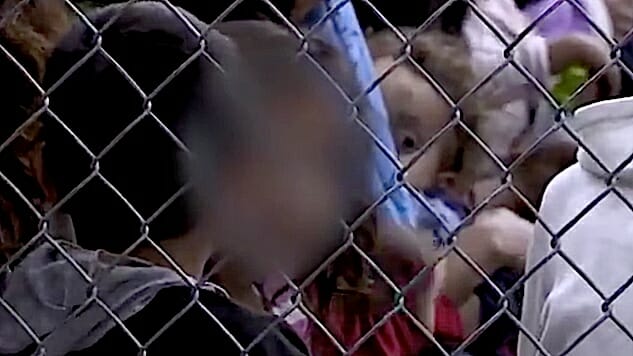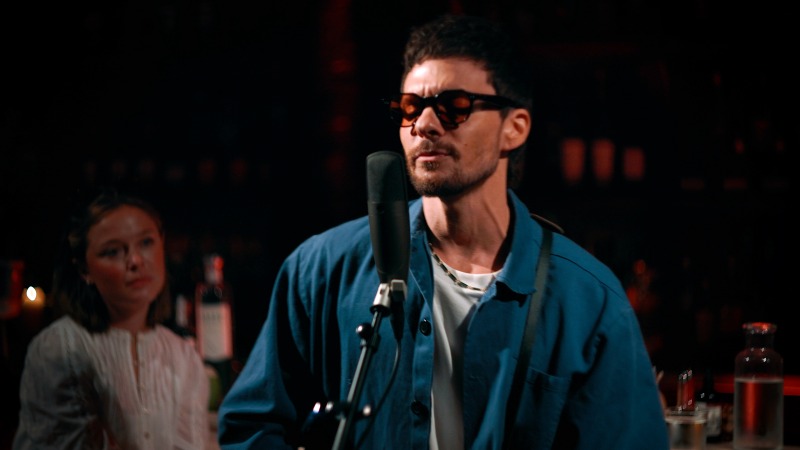It’s Unconstitutional To Detain Women and Children as a Deterrent
Photo courtesy of Getty
In a press conference Monday, a reporter asked the head of the Department of Homeland Security Kirstjen Nielsen why the government has only released images of boys separated from their families and detained in cages at the border. Nielsen passed the buck to the Department of Health and Human Services, and when pressed further she said “I’ll look into it.”
Nielsen said she hadn’t seen the images. Here’s a video that the Border Patrol, an agency under Nielsen’s leadership, recently released. Here are some of the still photos, which were included in a handout the Border Patrol distributed this week.
The question hangs, though: Where are the girls and babies? The reason we haven’t seen pictures of the girls is likely because the government doesn’t want to rip our already broken hearts out of our chests, set them on fire, and throw them into a barren winter field, where we will chase after them, use them them to light torches, then replace them burning in our chests and dismantle this heartless and strange system from the ground up.
Perhaps there’s another reason: In 2015 Federal Court of Appeals ruled it unconstitutional to detain women and children as a deterrent.
But even though we don’t have these photos, the long history of abuse from Border Patrol and ICE agents offers an idea of what the detention of women and babies might look like. This piece will explore what happens when we take girls and toddlers from their parents, and why the dangers young women face in emigrating here are particularly severe. This should make it pretty clear why a court might find this revolting and unconstitutional.
First: Where the babies go
News broke last night about what we’re doing to the “tender age” children (more or less under 13) we now, thanks to new Trump policies, separate from their parents. It’s now being reported that we send separated babies and other young children to at least three “tender age” shelters in south Texas. The government now plans to open a fourth such shelter. In other words, we’re detaining babies.
In relatively good news, these facilities are staffed with people who have experience handling young children. Trump’s policy created a surge of “unaccompanied” minors, so the shelters and staff we had in place weren’t prepared to take in all the toddlers and babies (some breastfeeding) we took out of the care of their parents. In the words of South Texas pediatrician Marsha Griffin, “The shelters aren’t the problem. It’s taking kids from their parents that’s the problem.”
But there are of course problems: Michelle Brané, director of the migrant rights and justice program at the Women’s Refugee Commission, told AP that “there is no model for how you house tons of little children in cots institutionally in our country. We don’t do orphanages, our child welfare has recognized that is an inappropriate setting for little children.”
Officials aren’t certain how, when, or if migrant parents and children will be reunited, and it’s possible they’ll never see each other.
The White House says families are only apart for five to ten days, but John Sandweg said separations can be permanent. The system can process parents quickly from detention to deportation, but children get processed more slowly. Why? Because for some reason kids are a lower priority. “You could easily end up in a situation where the gap between a parent’s deportation and a child’s deportation is years.”
Who’s John Sandweg? The acting director of ICE from 2013 to 2014
And if parents don’t have access to legal representation back in their home country, the prognosis is even worse. Eventually children who can’t find homes with relatives here will be put up for adoption. One father was separated from his four-month-old. The father got deported, and now, four months later, he Skypes with his infant.
But it’s not a recent problem. In April the New York Times reported that immigration officials have already taken more than 100 children younger than four away from their parents. Since October. Half a year before Trump’s policy that breaks up families went into effect.
That’s Trump’s problem.
But these families often face bigger problems of their own.
What the women and girls go through
The debate is about compassion. Policy and partisanship cover the human stories that drive immigration, and those stories are horrific, particularly for women. These women face a world of threats virtually unknown to most of us in the United States. We aren’t turning greedy people away. We’re returning desperate, hunted people to their hunters.
Girls come to the U.S. border fleeing violence, rape, human trafficking, and threats so horrific they choose to risk their lives on the trip. Many come from Mexico, a country mythologized in the United States for its gang violence and human trafficking. But a great many women also come from El Salvador, Honduras, and Guatemala, all three of which are among the top ten nations by murder rate worldwide. El Salvador and Honduras are consistently one and two.
Tarah Demant, senior director at Amnesty International USA, said many women who try to travel to the U.S. from that region “take birth control expecting to be raped” along the journey. According to Demant, “It’s worth the risk of almost certain sexual violence for them to reach what they think is a safe place.”
Those women show up to our border asking our compassion. If we deny them asylum, which Trump is trying his damndest to do, they’d get deported. Back home.
Where do they go today?
First we have to clear up the difference between federal immigrant detention centers and long-term shelters. Press reports and photos came out about both at the same time, so it’s easy to confuse them as being the same thing. Even though they’re part of the same system, they’re not the same, conditions aren’t the same, they don’t employ the same type of people, and they don’t perform the same functions. Those are critical differences.
Here’s how kids would go through that system.
When a family crosses into the U.S. illegally, they’re detained by DHS. They’re then taken to Border Patrol detention centers for intake and screening. The parents are arrested and (most often) put in the custody of U.S. Marshals. We can’t put kids in jail with their parents, so we put the children in separate detention facilities. It’s been our long-standing policy to put unaccompanied minors who show up at our border into shelters, where they wait while the system tries to find them a home.
But then this April, Trump changed what was previously a discretionary prosecution policy to a mandatory policy: DHS must prosecute all parents who cross. Mom and dad go to jail, which makes their kids “unaccompanied” by default. For decades we didn’t do this, because it’s revolting. Instead we held families together in detention centers and per court order released them after at the most 20 days. They later came back to immigration court to hear their fate. Trump calls this “catch and release,” which is how you talk about fish, not people. At a rally in West Virginia he said these families are “supposed to come back within two or three years for a court case, but nobody ever comes back.” This is a lie. In 2017 about two-thirds of them came back, and many won their release.
But under Trump’s new “zero-tolerance” policy, DHS separates kids from their parents during intake and screening. After that they’re separated by gender and held for up to 72 hours, which is when DHS typically puts them in the custody of the Office of Refugee Resettlement (part of the Department of Health and Human Services). ORR places the kids in shelters, most of which—though not all—are non-profits contracted by HHS. This is the same process unaccompanied minor asylum-seekers went through for years.
According to a source who works for one of these contracted organizations, girls and boys are never roomed together. (Shelters have rooms, not cages.) Babies and toddlers reportedly have their own areas within these shelters, sometimes even a separate wing or building.
But the babies and toddlers thing is new: After all, babies don’t typically show up unaccompanied at the border claiming asylum. Their parents bring them, and Trump’s new policy means babies have to be taken away, too. Shelters have little to no experience handling children this young, so they’ve had to adapt on the fly, a predictably messy challenge.
As for who’s looking after these kids, all or nearly all of these contracted shelters are non-government entities, and federal government employees don’t work there. Shelter employees, it seems, are by and large good people who originally signed up to help disadvantaged asylum-seekers. Now they’re caught in the middle of a shitstorm.
The sheltering sky
Many of these contracted shelters are licensed for single-gender use, but some are mixed. None of them have been prepared to take in an influx of infants and toddlers.
For a familiar example, take Casa Padre, the former Walmart that made headlines last week, partly because it featured what appeared to be a Trump propaganda mural. Other reporting mentioned, however, that Casa Padre has murals dedicated to many presidents, and it apparently also features murals dedicated to famous minority progressive figures such as Martin Luther King, Jr.
Casa Padre isn’t a government-run detention center such as the one in McAllen, Texas, where those photos of boys in cages were taken. It’s a non-governmental, not-for-profit contracted shelter.
That particular shelter, run by the Southwest Key non-profit organization, was originally built to house unaccompanied minors—sometimes including girls—who sought asylum on their own while ORR tried to find homes for them. In recent years we’ve seen a surge of unaccompanied minors fleeing increased gang violence and threats of human trafficking to seek asylum in the United States. Many believe, justifiably, that the Obama administration’s policies exacerbated the seriousness of this issue.
But it often takes a long time to process an unaccompanied minor through the system and into a permanent home. That’s why Casa Padre, a temporary home where children work with case workers to reunite with their families or find a permanent home, is literally the size of a Walmart. Today, however, Casa Padre also has to account for the additional influx of “unaccompanied” minors that Trump’s new policy just created, and it’s simply running out of space. The shelter went from housing 500 kids in April to its capacity of nearly 1500 today.
As a result of overcrowding in all shelters, which in turn is a direct result of Trump’s new policy, HHS has decided to put kids in tent cities. The first of these camps—a 450-bed compound—has been built in Tornillo, Texas, where summer is in full swing and temperatures have already hit triple digits.
So yes, there appears to be a vast difference, then, between the types of facilities the government runs—cages—and the types of facilities like those of Southwest Key.
That said, Southwest Key, which runs 26 facilities nationwide and 17 in Texas, has received fully half the money the government has allocated to organizations housing unaccompanied immigrant minors this year. The non-profit has a $1.5 billion government contract this year. To date in 2018 the group has received double the amount they received in all of last year. The organization’s CEO, Juan Sanchez, made more than $1.5 million in 2016. Last year, Texas state health inspectors cited Southwest Key for dozens of violations, including instances of inadequate supervision and failure to provide timely medical care.
A Southwest Key employee told CNN in reference to being asked to carry out an ethically dubious order, “And [I] basically realized that being in Southwest Key … despite the good I was doing, would mean that I had basically come up to doing things I felt were morally wrong.”
However, that quote might also serve to remind us that the employees who choose to work in these facilities are generally there to do good by these children. And we need these people right now to handle this crisis. The Trump administration’s new policies have put good-hearted workers in a tough spot: Be complicit, or walk away from the people they want to help. Along these lines, it’s hard to see whether any boycott, economic action, or political pressure applied directly to these organizations will do much good in the greater sense: We need these organizations in the short term, because they’re the only ones equipped to take care of these kids.
This means there’s a sort of double-hostage scenario here. These nonprofits have a distinct political advantage: They can condemn the administration’s policy as one that stops them from doing their jobs. The only recourse the administration seems to have at its disposal would be to cut funding (out of, for example, the $1.5 billion that Southwest Key just received), but to do so would be practically suicide. No one else can handle the waves of unaccompanied children that Trump has washed on their doorstep.
Here’s a salient comparison between the position of these providers and the position of the government, courtesy the United Nations:
What went largely unreported in the press’s coverage of Casa Padre, is that the Southwest Key organization, which operates some 26 facilities, was recently recognized by the UN Council on Human Rights for providing “excellent support to unaccompanied children.” Compare that with what the HRC said this Monday about the U.S. government and its new immigration policy: “The thought that any state would seek to deter parents by inflicting such abuse on children is unconscionable.”
Coincidence: Yesterday the United States announced that it is leaving the Human Rights Council.
So it’s the government detention centers, not the long-term shelters, which pose the biggest threat to girls and babies. What’s going on there?
No shelter here
When we pull back and look at how ICE and Border Patrol have treated women and children, it looks bleak.
Earlier this year a Honduran woman came to the Texas border with her 18-month-old son. According to the New York Times, she told border officials that the two of them escaped their home “through a cloud of tear gas… and needed protection from the political violence there.” In sworn testimony to a federal court, the woman said the agents told her to put her son in the back seat of a government vehicle. Then they drove away.
This happened February 20, two months before Trump enacted the new prosecution and separation policy.
Months before that, the Border Patrol separated a four-month-old from its father. The father was deported, and now he Skypes with his infant, today eight months old.
And remember that the Times reported a trove of data it got from ORR that showed more than 700 instances where immigration officials took children—including more than 100 children younger than four—away from their parents, before the new policy.
As for the current crop of horrors, in April the Border Patrol took 18-month-old from its mother. Representative Joaquin Castro reported seeing an 8-month-old boy in detention. One woman alleged that agents took her baby from her while she was breastfeeding, and when she resisted they arrested her.
A teenage girl at the McAllen government detention facility told reporters she had to care for a toddler she didn’t know, because the toddler’s aunt was kept in a separate part of the facility. She couldn’t find the aunt, and had to show other people in her cage how to change a diaper.
And we don’t seem to be equipped with resources—including brains—in the cases where we can’t separate. This March a 15-year-old indigenous Guatemalan girl reportedly had to stay in a male-only facility with her father, and reported the only privacy she got was when she showered.
The lack of resources in our immigration agencies extends from brains to hearts. The ACLU and Human Rights Watch have accused detention guards of several instances of sexual and physical abuse against women. Guards have also been accused of conducting unlawful strip searches.
And again, many if not most of these women have been traumatized before, or are escaping potentially traumatic scenarios. The Unitarian Universalist Service Committee conducted a study in 2015 that found immigrants were at high risk of re-experiencing past traumas while they were detained, including post-traumatic stress disorder (PTSD).
Detention centers aren’t friendly spaces. They’re not safe. There’s no professional psychological support. The staff is overwhelmingly male, which beyond the physical threat complicates things further. For instance, many women are ashamed to ask male guard for menstruation products.
If we could see the emotions, the shock, the trauma, and the fear in the faces of these girls—or the babies we’re not at all equipped to care for—the pitchforks would be whetted, torches gassed and lit.
But the law might save us
It’s hypocritical and fundamentally stupid that Trump’s policy punishes the very people—women and children—who would be victims to the human traffickers and smugglers the administration is claiming it wants to deter on national security grounds.
Turns out it’s not only stupid, it might be unconstitutional. The Ninth Circuit Court of Appeals addressed specifically this in its 2015 decision in RILR vs. Johnson. That ruling read in part that DHS cannot “detain Central American mothers and children with the aim of deterring potential future immigrants… such detention violates the Fifth Amendment.”
We have Trump officials on record calling the new policy “a deterrent.” In 2017 Jeff Sessions instructed border states and any “appropriate agency to develop a set of guidelines for prosecuting such violations. These guidelines should aim to accomplish the goal of deterring first-time improper entrants.” The reason he changed the new policy in April was because he wasn’t satisfied with their efforts to deter. And in an interview on Fox News, Sessions, when pressed by Laura Ingraham on whether the administration’s new policy was intended as a deterrent, said, “I see that the fact that no one was being prosecuted for this was a factor in a fivefold increase in four years in this kind of illegal immigration. So, yes, hopefully people will get the message and come through the border at the port of entry and not break across the border unlawfully.”
Also, the acting assistant secretary of HHS, Steven Wagner, explicitly called attention to the “deterrence effect” in a call transcript from CNBC reporter Christina Wilkie. And John Kelly told NPR last month it was intended as a deterrent. He said the same thing a year ago.
The administration will no doubt argue that our national security outweighs this concern, citing MS-13 or whatever. But the court denied Obama this argument in 2015:
…neither those being detained nor those being deterred are certain wrongdoers, but rather individuals who may have legitimate claims to asylum in this country. The Court, moreover, is rendering no judgment on the Executive’s authority to use other means at its disposal to deter mass immigration. But when its chosen vehicle demands significant deprivation of liberty, it cannot be justified by mere lip service.









































